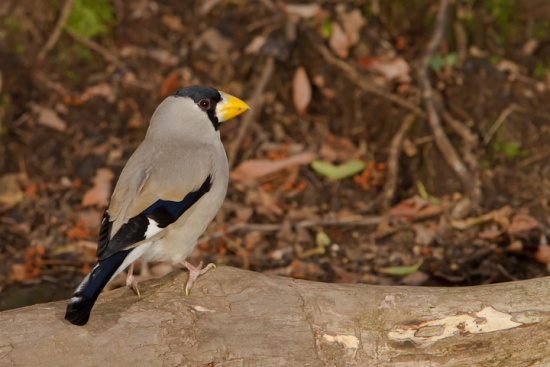Alternative names: Japanese Hawfinch; Masked Hawfinch; Masked Grosbeak; Black-headed Grosbeak
- Eophona personata
Identification
18-23 cm. A large finch with a large bill and bold markings.
- Large yellow bill
- Black face and crown
- Mid-grey plumage, tinged brown on tertials, grey on vent
- Glossy black wings with bold white patch midway along primaries
- Glossy black, forked and long tail
- magnirostris is larger than personata, paler and has a smaller white patch in the primaries
Sexes similar. Juveniles are more brownish, the black on the head is reduced to the lores and the base of the bill.
Distribution
East Asia: Breeds in Japan, northeast China and the Russian Far East. Winters in southern China.
Common to locally abundant. A common cagebird in China, trapped in large numbers.
Taxonomy
Two subspecies recgnized:
- E. p. personata breeds in Japan (Hokkaido to Honshu) and winters in southern Japan
- E. p. magnirostris breeds in the Russian Far East (eastern Amurland, southern Ussuriland), on Sakhalin and in northeast China (Heilongjiang and eastern Jilin); winters in southern China (Guizhou to Fujian)
Habitat
Found in mixed and deciduous forest and woodlands. Also on well-wooded hills, river valleys, parks, gardens and edges of cultivation. Occurs mostly in lowlands.
Behaviour
Diet
Feeds on seeds and fruit. Takes also insects and caterpillars, especially in summer.
Forages in pairs or small flocks in trees and sometimes in lower bushes. Often stays hidden within foliage of canopy and easiest detected by its contact calls.
Breeding
Not well known. Breading season from May to July. The nest is a large, deep cup. It's made from twigs and sticks, broad grass blades and stems and placed 2-6 m above the ground in a tree. Lays 3 to 4 eggs.
Movements
Subspecies magnirostris migrates south during September to November, sometimes later and north again from mid-March to June. On passage in South Korea from April to June, scarce on passage and as winter visitor in Hong Kong. personata is only partially migratory but has also been recorded in Korea and rarely in Taiwan. Vagrants have reached India, Laos and southern China. Records of birds in Europe are believed to be captive birds.
References
- Clements, J. F., T. S. Schulenberg, M. J. Iliff, D. Roberson, T. A. Fredericks, B. L. Sullivan, and C. L. Wood. 2014. The eBird/Clements checklist of birds of the world: Version 6.9., with updates to August 2014. Downloaded from http://www.birds.cornell.edu/clementschecklist/download/
- Handbook of the Birds of the World Alive (retrieved November 2014)
Recommended Citation
- BirdForum Opus contributors. (2024) Japanese Grosbeak. In: BirdForum, the forum for wild birds and birding. Retrieved 19 April 2024 from https://www.birdforum.net/opus/Japanese_Grosbeak




